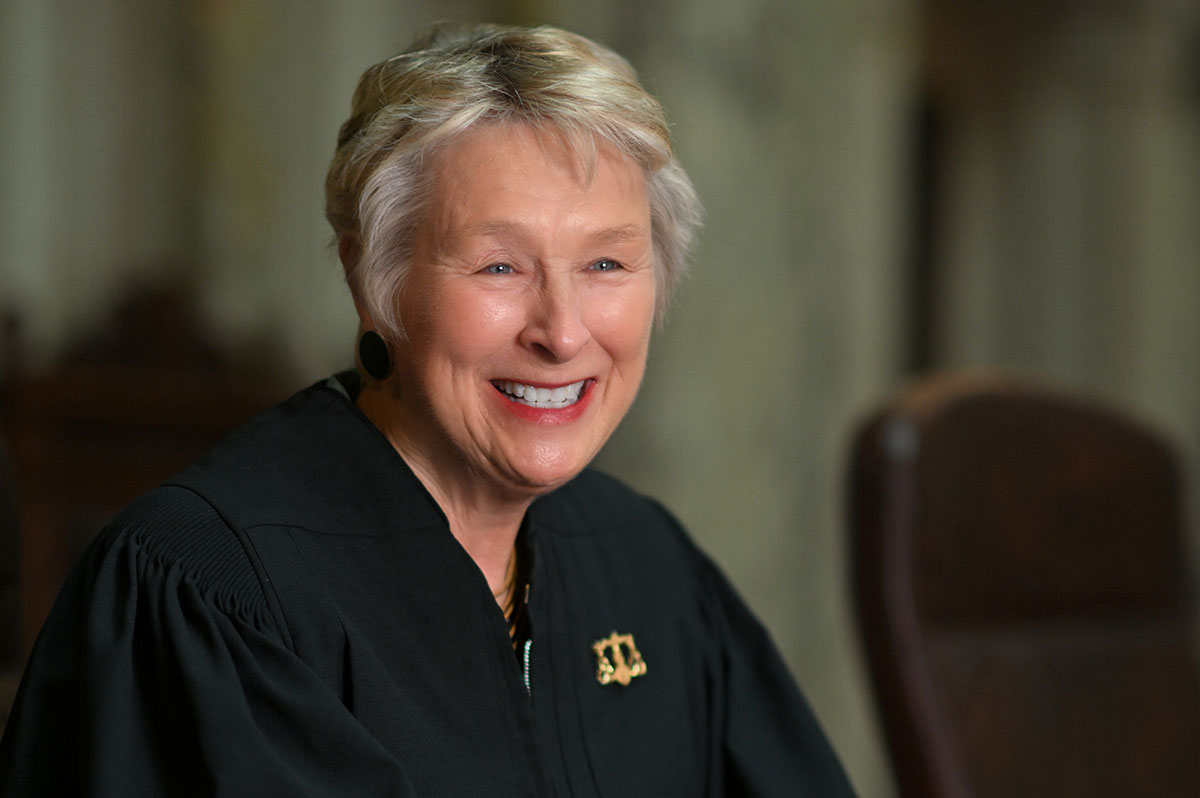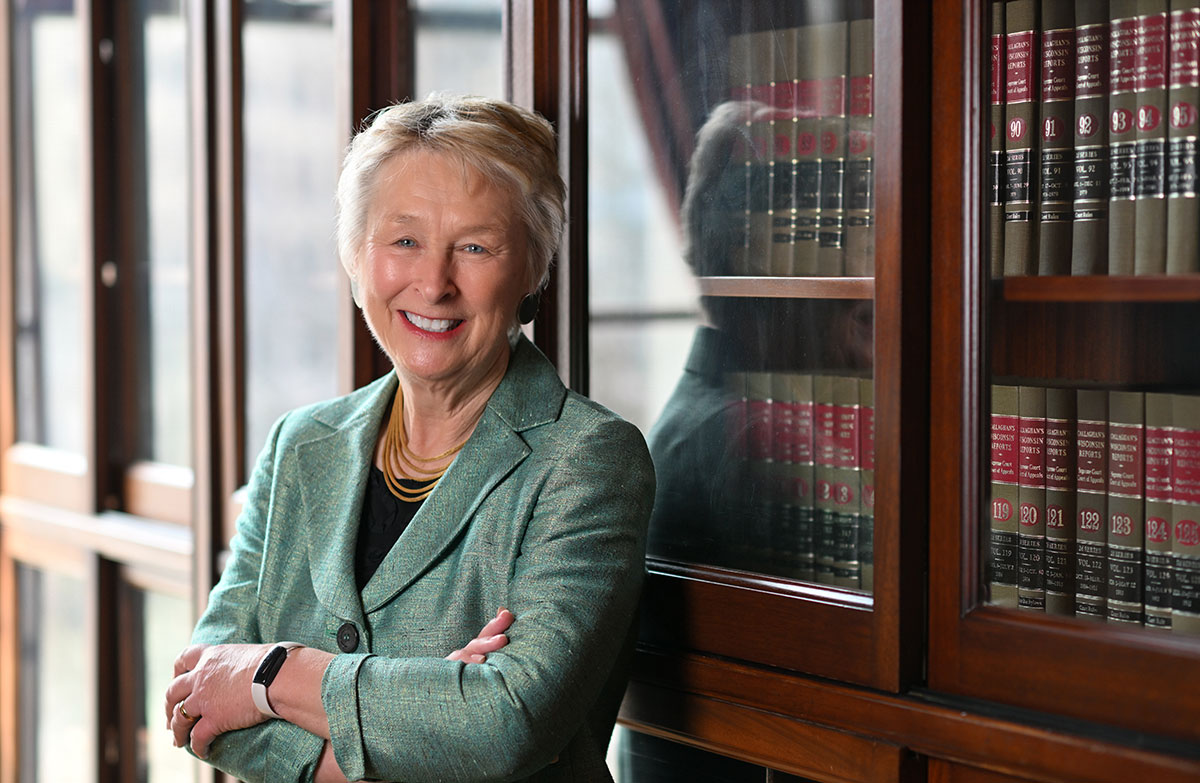
Photos by Tatiana Shirasaki
Chief Justice Ann Walsh Bradley remains one of the first women in many categories in a state not just native to her but where her family has lived since Wisconsin was new.
Even with all those accomplishments – as litigator, circuit court judge, and the fifth longest serving Wisconsin Supreme Court justice – Bradley lives the values and gratitude she learned growing up in Richland Center.
“This job is a calling, just like being a circuit court judge is,” said Bradley, who has served 30 years (3 terms) as a Wisconsin Supreme Court justice, including two months as chief justice when she retires on July 31, 2025. “I think it’s an extension of my teaching years … all kind of intertwined with the sense of justice, and so the opportunity to be one of seven as an instrument of justice in this state is a remarkable opportunity.”
“I feel so fortunate to have been a part of, to serve the people of this state on the Wisconsin Supreme Court.”
Colleague Testimony
Her supreme court colleagues testify to Bradley’s contributions, intelligence, work ethic – and playfulness.
 Jay D. Jerde, Mitchell Hamline 2006, is a legal writer for the State Bar of Wisconsin, Madison. He can be reached by email or by phone at (608) 250-6126.
Jay D. Jerde, Mitchell Hamline 2006, is a legal writer for the State Bar of Wisconsin, Madison. He can be reached by email or by phone at (608) 250-6126.
“Justice Ann Walsh Bradley has served the state of Wisconsin and this court for nearly 30 years,” said former Chief Justice Annette Kingsland Ziegler. “She has been a colleague of mine since I joined the court in 2007. I wish her all the best.”
Justice Rebecca Frank Dallet feels honored to have worked with Bradley, whom she called “a powerful voice for judicial excellence, civic engagement, and the values that underpin a fair and impartial judiciary.”
“Few individuals have had as enduring and meaningful an impact on Wisconsin’s legal system as Justice Ann Walsh Bradley. Her work on the bench has shaped precedent and strengthened the administration of justice in significant ways,” Dallet said.
“I’ve learned so much from Ann, and I deeply appreciate her as a colleague and a friend,” Dallet said.
Janine Geske, distinguished professor of law at Marquette University Law School and supreme court justice from 1993 to 1998, remains in contact with her former colleague, someone she knew from when they were among the rare women circuit court judges in the 1980s.
Bradley “was super prepared,” Geske said. “She would work all night long and work on those cases. She’s not afraid to be tough in the conference room, as we’ve seen, and take a strong position, but she tries to find the middle ground.”
Geske describes Bradley as “intellectually curious” and “an incredibly devoted mother,” and more personally, “She is just a delightful woman. She’s funny. She’s fun. She sings.”

Richland Center Values
“Richland Center is very much a part of who I am today,” Bradley said. “That’s where my values are. That’s where my family is.”
Bradley grew up in the house her grandparents had owned, where her dad was born, at the center of a large extended family. Her dad was a bartender, which was difficult because, Bradley said, Richland Center was “dry” until the 1980s. One couldn’t bartend in the city limits. You couldn’t find alcohol to buy.
A Milwaukee newspaper once described Richland Center as “the hotbed of the women’s suffragette movement,” Bradley said, ground zero for the U.S. Constitutional amendment giving women the right to vote, a movement related to temperance.
Richland Center formed Bradley’s beliefs. “I really believe strongly in rural Wisconsin values,” she said, “which in my mind are family and community and hard work, so that’s a good part of who I am today and what I believe in.”
Those values continued after earning her undergraduate degree. She taught issues of social justice for a year at Aquinas High School in La Crosse as the first lay religion teacher in the Diocese of La Crosse, Bradley said.
After a year of teaching, Bradley went to the University of Wisconsin Law School.
Central Wisconsin Litigator and Judge
Bradley’s family had no lawyers in it. None of her aunts, uncles, and parents had graduated from college, Bradley said. Perry Mason showed the way.
“That was an old show about a trial lawyer, and he always won. And he was a litigator. So, I thought I wanted to do litigation,” Bradley said.
She also continued to keep alive “the idea of doing something that would in a general sense deal with issues that touch upon justice and social justice,” Bradley remembered.
In her first lawyer job, she worked for three years at Wausau Insurance Co. as a litigator. “I was the first woman to do a civil jury trial in several counties in central Wisconsin.” She remembers specifically being first in Marathon, Winnebago, and Langlade counties.
“All the depositions, all of the motion hearings, all of everything was male, except for me,” Bradley remembers.
In her six years of private practice that followed, Bradley’s clients included the city of Wausau, working both prosecution and defense, such as defending law enforcement against 42 U.S.C. section 1983 due-process claims, Bradley said.
Public service beckoned. Gov. Tony Earl appointed Bradley to the Public Defender Board, and Gov. Earl appointed her in 1985 as Marathon County Circuit Court judge.
“The launchpad was really being a woman attorney,” Bradley explained. When she started working in Wausau, she was among the first women attorneys in central and northern Wisconsin, and when she became judge, she was one of three women judges north of Madison and Milwaukee. She served at the circuit court for 10 years, winning two elections.
When she joined the supreme court, she was the third woman justice – and now the seven-justice court has six women justices.
“I don’t know if I expected it. Of course, we’re the highest percentage of women on the bench of any state in this country,” Bradley said. “So, that’s rather remarkable.”
Judicial Elections, 1995 Style
Bradley had a noticeable campaign for the 1995 supreme court election. It was a different world from today.
She garnered conspicuous bipartisan support. Tony Earl, former Democratic governor, and Sue Ann Thompson, wife of the sitting Republican Gov. Tommy Thompson, co-chaired Bradley’s first election campaign.
In subsequent elections, Bradley also benefited from the support of Lee Sherman Dreyfus and Scott McCallum, both Republicans, and Jim Doyle, a Democrat, but “Sue Ann was my co-chair in all of my elections.”
In 1995, voters in Wausau and Marathon County knew and supported her, and her connections with the Wausau Police Department helped bring in law enforcement support statewide, Bradley said.
Her extended family may have been her secret weapon. The family gathered in Madison as a central location, calling people and introducing postcards as campaign outreach, Bradley said.
“That wasn’t a part of elections at the time,” Bradley said. “My sister-in-law who lives in Chicago said, ‘Ann, we get postcards in Chicago for elections.’” The campaign kept on printing postcards and family kept sending them out.
She faced candidates whose names are familiar, including N. Patrick Crooks from Green Bay, elected to the court in 1996, and Patience Drake Roggensack from Madison, elected in 2003 and later chief justice.
“We had a very vigorous primary,” Bradley remembered, “in fact, I always liked to tease [Pat Crooks], to remind him that in the primary I took 60 of the 72 counties.”
In the Feb. 21, 1995, primary, Bradley netted 131,889 votes to Crooks’ 88,913, out of 339,526 votes among the five candidates.[1] In the April election, she won with 514,588 votes to Crooks’ 424,110.[2]
The price for this campaign is also truer for 30 years ago than today. A headline after the election, Bradley remembers, credited her with breaking “all-time spending records.”
“Remember, this was vigorous against really substantial candidates, and it was just a little over $400,000,” Bradley said.
In the 2025 supreme court election, about $100 million was spent.
Tired Years
Bradley is the first woman justice elected to the supreme court as a non-incumbent, joining Geske and Shirley Abrahamson who reached the court initially by gubernatorial appointment. Bradley and Geske were friends on the court, and they remain close.
Abrahamson, who had been Bradley’s tax professor at the University of Wisconsin Law School, became a meaningful influence on Bradley “as a friend who was a colleague.” Abrahamson’s “exceedingly high ethical standards and very strong work ethic,” as Bradley described them, influenced her the most.
When Bradley joined the court, she had another central Wisconsin friend there. Justice William A. Bablitch, former Wisconsin State Senate majority leader, had encouraged Bradley to run for supreme court and advised her during the campaign, Bradley said. His advice continued when she joined the court.
Living in Wausau those early years, she left for work at 6:30 a.m. and left for home at 4 p.m. for the nearly two-and-a-half-hour commute. She maximized her time in Madison and “didn’t socialize much.”
Sometimes she stopped at the rest area near Westfield on the way home. If court wasn’t in session, she could work in an office at the court of appeals in Wausau or at home. Those were exhausting years.
“Those were years with not as much sleep as I probably should have had,” Bradley remembers.
A Busy Court
In Bradley’s first term, 1995-96, the supreme court released 75 authored opinions, of which Bradley wrote 10 majority decisions.
Bradley had to adapt. She told Wisconsin Lawyer shortly after starting on the court that “the toughest part of the transition has been the volume of reading necessary for good preparation. ‘To be told that is one thing,’ she point[ed] out. ‘To experience it is another. Preparation could be endless.’”[3]
The jump from circuit court, where you are “responding to the fire in front of you,” also differed from her new job. She learned to take time to reflect, to synthesize what she had read, Bradley said in 1995.[4]
“The job, the workload, the number of cases that we handled were so many more,” with only one law clerk instead of the two she has today, “and so the workload was intense,” Bradley said.
With four kids at home, she worked late nights and weekends. On Saturday mornings, while her kids were playing basketball, Bradley said, she “would take … petitions for review to the bleachers and watch the game and do petitions for review.”
Fewer Cases, Bigger Issues
Bradley has written a total of 561 opinions in her career through the 2023-24 term, the most recent full term available in SCOWstats, a website developed by Alan Ball, a Marquette University history professor. In 29 years on the court, she’s written a total of 256 majority opinions, 95 concurrences, and 210 dissents.[5]
In Bradley’s first 10-year term on the court, supreme court caseload ranged from a high of 96 authored decisions in 2004-05 to a low of 72 decisions released in 1997-98. Bradley wrote her one-seventh share of majority opinions, about 116, plus 98 concurrences and dissents combined during those 10 years.[6]
Since the 2006-07 term, however, the number of authored decisions has consistently decreased, varying from 68 to 40 released cases through the 2022-23 term. In the most recently completed term, 2023-24, the court released 14 authored majority opinions.[7]
The number of opinions Bradley authored, including concurrences and dissents, maxed out at 26 in the 2003-04 term and 25 in the 1998-99, 2000-01, and 2017-18 terms.[8]
Cases on appeal have gone down nationally, Bradley said. Commentators have attributed the change, at least initially, to the rise of alternative dispute resolution, “and I think that still is a huge part of the lower caseload.”
The cases that arrive are bigger and may leave us with more opinions, she said. “The cases we have now are consistently of such import and big cases,” and that may come from “when the other two branches of government are at odds with one another,” Bradley said, referencing commentators.
These decisions govern Wisconsin, but they shape law across the country.
“When I got on the court, states around the country looked to us to develop the law,” Bradley said. “We were considered one of the top state supreme courts in the country, and they would cite our opinions, and that’s how you measure the respect they had for the court.”
“That’s happening again with fewer cases and cases that involve larger consequences.”
Dissent
Even a justice in the minority has something to say. Bradley didn’t have terms with double-digit numbers of dissents until 2008-09, when she wrote 12, as she did two years later. About one in five authored majority decisions released in those terms had a Bradley dissent.[9]
For three terms, from 2016-17 to 2018-19, she authored 14 dissents each year. About one-quarter of all authored majority decisions released in those terms included a Bradley dissent.[10]
“For so many years, I’ve been writing a lot of dissents,” Bradley admits. Her husband, a lawyer, wondered if anyone reads dissents. Visiting with law professors nationwide gave her vindication. “The professors who came forward to me indicat[ed] that they not only read my dissents, they teach my dissents.”
“So, it does make a difference. And then of course, one of the reasons of writing dissents is hoping that those dissents someday become majorities.”
Retirement?
Don’t call it retirement. Technically, Bradley’s term expires on July 31, 2025, but she doesn’t call it retirement. She still has work to do.
In May and June, Bradley is serving as chief justice. The justices elected her to the position April 3. Starting July 1, 2025, Justice Jill J. Karofsky will serve the remainder of the two-year chief justice term.
The chief justice “is the administrative head of the judicial system” as established by the Wisconsin Constitution.[11] In the supreme court, the chief justice “may schedule oral arguments, decision conferences, and administrative conferences”[12] and presides at conferences deciding cases and motions.[13]
Bradley participates in many organizations for the betterment of law and civics. The list takes up two large paragraphs in her official biography. She will continue some of these activities in retirement. Foremost among them are organizations that support law around the globe.
As chair of the board of trustees of the International Association of Women Judges, Bradley helps run an organization with 6,500 members in 143 countries advancing gender equality and human rights. “Once my tenure ends, I will be able to give more time to the International Association,” Bradley said.
She also focuses attention on iCivics, a program created by late U.S. Supreme Court Justice Sandra Day O’Connor, that offers engaging programs to teach students about civics.
“And I do have a loving husband and four kids and seven grandkids,” Bradley said.
Gratitude
Family means a lot to Bradley. Every morning as a part of her meditations, she remembers them, those who are alive and those who are gone. With that family, she is rooted in the state she has long served, thankful for the trust the people have placed in her.
She tries to pay it back by showing respect for those around her. “It’s amazing that this job gives me the opportunity to make people feel special. That’s a real gift. I mean, not every job offers that opportunity.”
These values will go with her even after she leaves her chambers in the east wing of the Wisconsin State Capitol.
She starts each day pledging to “embrace this day with joy and an attitude of gratitude,” go outside to watch the morning sunrise, “and grace this day.”
Authored Opinions by Chief Justice Bradley
Endnotes
[1] Wisconsin Blue Book 1995 – 1996, at 879.
[2] Id. at 883-84.
[3] Dianne Molvig, Profile, Ann Walsh Bradley:Wisconsin’s Newest Supreme Court Justice, Wis. Law., Dec. 1995, at 46, 48.
[4] Id. at 48.
[5] Compiled from SCOWstats, https://scowstats.com.
[6] Compiled from SCOWstats.
[7] Compiled from SCOWstats.
[8] Compiled from SCOWstats.
[9] Compiled from SCOWstats.
[10] Compiled from SCOWstats.
[11] Wis. Const. art. VII, 4(2).
[12] Sup. Ct. Internal Operating Procs. III.A, www.wicourts.gov/sc/IOPSC.pdf.
[13] Id. III.E.
» Cite this article: 98 Wis. Law. 16-20 (June 2025).
